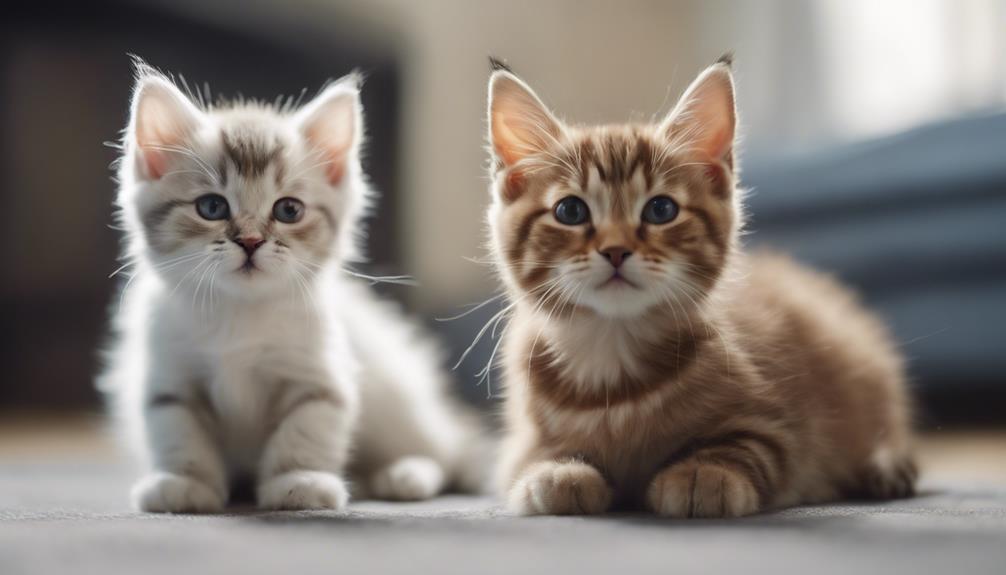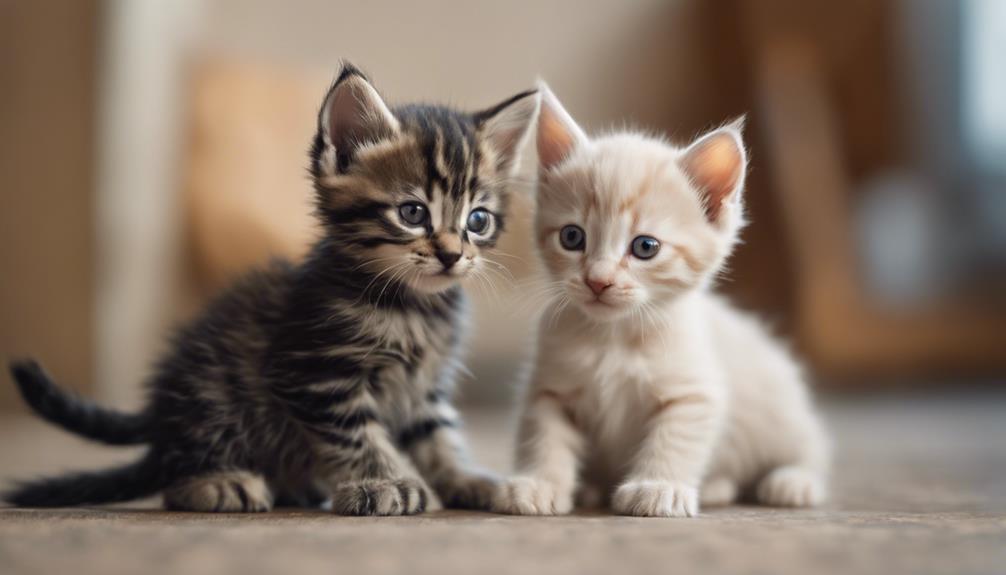Understanding the growth patterns of kittens is essential for pet owners invested in the well-being of their feline companions. From the delicate balance of breed characteristics to the influence of neutering, various factors play a role in determining when kittens reach their full size and maturity.
By unraveling the complexities of feline growth, we can gain valuable insights into ensuring the optimal health and development of our beloved cats. Stay tuned as we explore the nuances of when kittens stop growing and how to discern if your feline friend has reached their full potential.
Key Takeaways
- Kittens are almost fully grown after a year, with 95% of growth complete by nine to 12 months.
- Gender, breed, and neutering influence a cat's growth and size.
- Male cats are generally 10-15% larger than females, with growth impacted by neutering.
- Consult a vet for breed-specific weight information and transition to adult food accordingly.
Growth Timeline and Milestones
During a cat's growth timeline and milestones, the period from birth to one year marks significant developmental stages where 95% of growth is typically completed by nine to 12 months of age. In this crucial first year, most growth occurs in the initial six months, emphasizing the importance of providing proper nutrition to support bone and muscle development.
Kittens tend to gain around one pound per month in the first five months, with a consistent weight range of 12 to 14 pounds indicating that they have reached full growth potential.
Beyond physical growth, cats continue to mature socially and behaviorally after reaching adulthood, highlighting the holistic nature of their development process.
Factors Influencing Growth
Influencing a cat's growth significantly are factors such as gender, breed, and neutering. Male cats tend to be larger than females, with an average weight of around 14 pounds. Certain breeds, like Maine Coons, may take longer to reach full size due to breed-specific characteristics.
Neutering can also impact growth, especially in male kittens, with timing playing a crucial role in ensuring proper development, including urethra growth. Understanding these factors is essential for monitoring a cat's growth progress and addressing any potential concerns that may arise.
Breed-Specific Considerations

Understanding the unique characteristics of different cat breeds is essential for tailoring appropriate care and monitoring the growth and development of feline companions. Breed-specific considerations play a crucial role in understanding when kittens stop growing.
For instance, breeds like Siamese, Sphynx, and Khao Manee cats tend to be smaller in size, while Maine Coons can reach weights of up to 25 pounds. Consulting with a veterinarian for breed-specific weight information is recommended to ensure proper growth monitoring.
Transitioning to adult food should also be based on the specific breed and the maturity of the cat. By being aware of these breed-specific differences, cat owners can better understand their feline companions' growth trajectories and provide them with the necessary care.
Gender Differences in Growth
Gender distinctions significantly impact the growth patterns and size variations observed in cats. Male cats typically outweigh females by 10-15%, with an average weight of around 14 pounds for males. This difference in size is influenced by gender-related factors affecting growth.
Neutering can also play a role in male cat development, with early neutering potentially affecting the overall growth cycle and urethra development. To prevent disruptions, it is recommended to delay neutering male kittens until they reach around five to six months of age.
In contrast, spaying female cats does not have the same impact on growth. Understanding these gender-specific considerations is crucial for providing appropriate care and ensuring healthy growth and development in felines.
Neutering Effects on Growth

Neutering plays a significant role in shaping the growth trajectory of male kittens, particularly in relation to their overall development and potential effects on urethra growth. Neutering male kittens, especially when done early, can have implications on their growth cycle. It is recommended to delay the neutering procedure to ensure healthy growth and development, as premature neutering may halt growth and impact urethra development. Understanding the effects of neutering on growth is crucial for cat owners and veterinarians to make informed decisions regarding the timing of the procedure. The table below summarizes the key points regarding the effects of neutering on the growth of male kittens:
| Neutering Effects on Growth |
|---|
| – Impacts growth trajectory |
| – Potential effects on urethra development |
| – Delay recommended for healthy growth |
| – Contrasting effects on male and female cats |
Social and Behavioral Maturity
Social and behavioral maturity in cats is a gradual process that continues even after they reach physical adulthood. While physical growth typically slows down around one year of age, cats continue to develop socially and behaviorally throughout their lives.
Social maturity involves how cats interact with other felines and humans, establishing territories, and forming bonds within their environment. Behavioral maturity encompasses how they respond to stimuli, handle stress, and exhibit learned behaviors.
Factors such as early socialization, environmental enrichment, and individual temperament play a significant role in shaping a cat's social and behavioral development. Providing a stimulating environment, positive reinforcement training, and consistent interaction can help cats reach their full potential in terms of social and behavioral maturity.
Frequently Asked Questions
Are There Any Signs or Behaviors That Indicate My Kitten Is Done Growing, Besides Reaching a Certain Weight?
Behavioral signs such as decreased energy levels, less interest in play, and a more settled demeanor can indicate that your kitten has finished growing. Combined with reaching a stable weight, these cues suggest your feline companion has reached maturity.
How Can I Ensure My Kitten Is Getting the Proper Nutrients for Healthy Growth and Development?
Ensuring proper nutrients for healthy growth and development in kittens is crucial. Consult a veterinarian for a balanced diet tailored to your kitten's needs. Consider high-quality kitten food rich in protein, vitamins, and minerals to support their growth.
Do Indoor and Outdoor Cats Have Different Growth Patterns or Factors That Influence Their Growth?
Indoor and outdoor cats may have differing growth patterns influenced by environmental factors like exercise levels, diet variations, and exposure to potential health risks outdoors. These variables can impact the size, weight, and overall development of cats.
Can a Cat's Growth Be Stunted by Factors Like Stress or Illness, and How Can This Be Addressed?
A cat's growth can be stunted by factors like stress or illness, affecting bone and muscle development. Addressing underlying issues promptly through veterinary care and providing a conducive environment, balanced nutrition, and mental stimulation are crucial for optimal growth.
Are There Any Specific Exercises or Activities That Can Promote Healthy Muscle and Bone Development in Growing Kittens?
To promote healthy muscle and bone development in growing kittens, engage them in interactive play with toys like laser pointers or feather wands. Encourage climbing on cat trees and provide scratching posts for exercise. Supervised play ensures safety.
Can the Gender of a Kitten Affect its Growth and Development?
When it comes to determining the gender of a kitten, there is no scientific evidence to suggest that it affects their growth and development. The most important factors in a kitten’s growth are proper nutrition, socialization, and veterinary care. The gender of a kitten should not play a role in their overall development.
Conclusion
In conclusion, understanding the growth patterns of kittens is essential for responsible pet care. By considering factors such as breed characteristics, gender differences, and the effects of neutering, pet owners can better assess when their feline companions reach their full size and maturity.
Monitoring their development and providing appropriate care will ensure the optimal health and well-being of these beloved pets. Stay informed and attentive to your kitten's growth journey for a fulfilling feline companionship experience.




